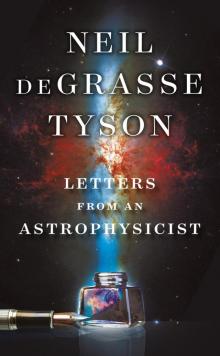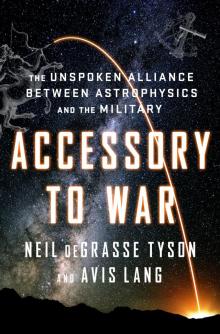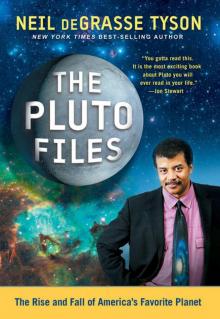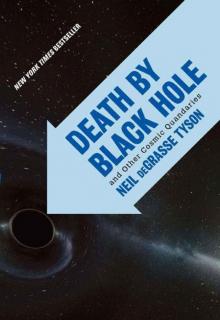- Home
- Neil DeGrasse Tyson
Accessory to War Page 3
Accessory to War Read online
Page 3
During a break in the proceedings, I opened my laptop and started perusing my email. But my mind, like the minds of everyone around me, was preoccupied with the war. The battle for Baghdad began on April 5.30 The first American transport plane carrying troops and equipment landed at the Baghdad airport on April 6. American troops took over Saddam Hussein’s main presidential palace on April 7, the opening day of the symposium. A gigantic Milstar satellite, the fifth of a constellation of five satellites geared for military communications, had been launched that very morning from Cape Canaveral, applauded at liftoff by General Lord. The American campaign of “shock and awe” seemed to be succeeding. And hanging in the sky was a different sort of Moon from the one that witnessed the start of the Gulf War. This phase was visible, a waxing crescent Moon. The coalition forces did not require the cover of a dark, moonless night, because the assault on Baghdad did not rely on airborne stealth. Much of the assault depended on infantry, tanks, and armored personnel carriers, invading by ground.
Suddenly the informational PowerPoint slides that ordinarily fill the hall’s large display screens during breaks were replaced by war coverage from CNN: Operation Iraqi Freedom, live and in color. Intense fighting was taking place in the center of Baghdad. The office of the news agency Al Jazeera had been bombed. The Palestine Hotel, preferred habitat of the international media, had been bombed. Tank-buster jets were hitting Iraqi positions on a bridge over the Tigris River. Helicopter gunships were pummeling a compound thought to be used by the Republican Guard. British troops were gaining control of Basra, Iraq’s second-largest city. On-screen, reporters and anchors and spokespersons and generals described the weaponry and announced the names of the corporations that manufactured it—the same names highlighted in the symposium’s display booths and printed on the badges of the people surrounding me. And every time a corporation was identified as the producer of a particular instrument of destruction, its employees and executives in the audience broke into applause.
Up to that point I’d felt okay. But now I was anguished. Once again, America was invading the soil of a sovereign nation that hadn’t attacked us. In video games you’re expected to cheer when you destroy your virtual targets and proceed to the next level. But it’s hard to accept that kind of behavior when your targets are real. People die when a Boeing B-1B Lancer drops a quartet of GBU-31 bombs on a Baghdad restaurant that Saddam Hussein has reportedly entered. People are killed when a barrage of Lockheed Martin AGM-114 Hellfire missiles strikes a convoy suspected to include Saddam Hussein.
Blinking back tears and fighting to keep my composure, I thought about leaving the conference. I began to choreograph my resignation from the board of the Space Foundation. But at the same time I felt I couldn’t just walk out of the sanctum of war and put my head in the sand. It’s better to see than not to see, I said to myself. It’s better to know than not to know, better to understand than not to understand. Then and there I grasped the unattractive, undeniable fact that without the Space Symposium, without the many symposia like it, without all its predecessors and counterparts across culture and time, without the power sought by its participants—both for themselves and for the nations they represent—and without the tandem investments in technology fostered by that quest for power, there would be no astronomy, no astrophysics, no astronauts, no exploration of the solar system, and barely any comprehension of the cosmos.
So I stayed put, and decided to explore other ways to reconcile my emotions with the histories, contradictions, priorities, and possibilities inherent in that day.
The universe is both the ultimate frontier and the highest of high grounds. Shared by both space scientists and space warriors, it’s a laboratory for one and a battlefield for the other. The explorer wants to understand it; the soldier wants to dominate it. But without the right technology—which is more or less the same technology for both parties—nobody can get to it, operate in it, scrutinize it, dominate it, or use it to their advantage and someone else’s disadvantage. Absent that technology, neither side can achieve its ends. In the words of the Rumsfeld Commission report, “The U.S. will not remain the world’s leading space-faring nation by relying on yesterday’s technology to meet today’s requirements at tomorrow’s prices.”31 The technology all sides seek is both cutting-edge and potentially dual-use.
So whether you’re an astrophysicist peaceably seeking a good look at Saturn’s rings or an army general aggressively seeking high-resolution satellite information about a bunker inside a mountain, you’re dependent on the same pool of engineers. Some of them work or consult for corporations; some of them teach at universities; some of them do both. Most of the contracts they work under, as well as most of the contracts for celebrated space-science projects, are funded with taxpayer dollars. NASA is a major funder of space research in academia, and most of the leading corporations contract to NASA in one way or another. The contract could come from a range of sources: Air Force Space Command, the Defense Advanced Research Projects Agency, the Air Force Research Laboratory, the National Reconnaissance Office, the National Aeronautics and Space Administration, a private company such as SpaceX. Doesn’t matter much. Whoever puts up the contract, both space scientists and space warriors will utilize the results.
Where do these aerospace engineers, astrophysicists, physicists, and computer geniuses come from, and where do they end up working? How do those agencies and companies attract them? Probably not by talking up their missile-defense contracts. These people want to do science. They want to do space.
Look at a recent Space Report from the Space Foundation or a Science and Engineering Indicators from the National Science Foundation, and you’ll see some eye-popping statistical trends: Knowledge-based and tech-intensive industries in the United States account for almost 40 percent of gross domestic product, the highest in the developed world, rendering this country’s economy deeply dependent on a highly educated workforce. Employment in science and engineering as a percentage of total employment doubled between 1960 and 2013, and immigrants formed a substantial part of that doubling. While the century-long average of US residents who are immigrants is about 10 percent, 33 percent of all the US Nobel Prizes in the sciences have gone to immigrants. Almost half the workers with doctorates in the physical sciences, and more than half with doctorates in computer science, mathematics, or engineering, were born outside the United States. Meanwhile, other countries—most notably China and India—are now far outpacing the United States in the number of first university degrees awarded in these fields, and the fraction of foreign-born US graduate students will diminish, since many of those other countries have been assiduously building their own academic infrastructure. At the rate we’re going, the United States will soon cease to be a prime destination of aspiring young scientists from “developing” nations—further starving our dreams of reclaimed greatness. What will happen when the ramifications of both xenophobia and the contraction of public support for higher education play out over the medium to long term? And simply tallying the numbers of students in graduate school doesn’t capture the full challenge. When it comes specifically to space, the civilian US workforce has been shrinking every year for the past decade or so, even as global space activity has been soaring. Japan’s civilian space workforce has increased two-thirds from its low point in 2008, and the European Union’s has increased by a third.32
No matter the absolute numbers in the United States, the PhD astrophysicist has few problems finding work. Astrophysicists are expert coders and trained problem solvers. We are fluent in multiple computer languages and comfortable with the analysis of large quantities of data, besides having a facility with mathematics that exceeds what most job descriptions demand. Those who don’t become professors or educators get snatched up by Wall Street, by NASA, by the US Department of Energy, by any of several branches of the US Department of Defense, or by the information technology or aerospace industries—out-earning their academic counterparts at every step.
> One company they might decide to join is Northrop Grumman. Its legacy runs deep. In the 1960s, the Grumman part of that merger built the module that delivered all moonwalking astronauts to the lunar surface. And from 2012 through 2016, Northrop Grumman fared significantly better than the S&P 500 Index. Government contracts, primarily from America’s Department of Defense and intelligence agencies, are its bread and butter. During the three-year period 2014–2016, the US government accounted for five-sixths of its total sales. Most of the remaining sixth comprised foreign military sales, contracted through the US government. Although Northrop Grumman characterizes itself as a “leading global security company” and foregrounds its military work—“We provide products, systems and solutions in autonomous systems; cyber; command, control, communications and computers, intelligence, surveillance, and reconnaissance (C4ISR); strike; and logistics and modernization”—it is also the prime contractor for NASA’s James Webb Space Telescope, a state-of-the-art, state-of-the-science infrared observatory designed to orbit the Sun a million miles from Earth as, alongside other goals, it tracks the birth of galaxies in the early universe. Conceived in 1996 as the follow-on to Hubble, the Webb telescope, named for the administrator of NASA during much of the Apollo era, represents a total cost of about $9 billion—about $375 million per year when spread from birth to launch. Feels like a lot, but it’s less than 2 percent of Northrop Grumman’s total annual sales.
No doubt a freshly minted astrophysicist would be thrilled to work on the Webb telescope itself or on the company’s petal-shaped Starshade screen, which is designed to fly thousands of miles in front of any space telescope, blocking the light of various stars so that their planetary systems can be studied. Plus, working in industry means a higher salary than a university can offer. So the attraction is strong. But, having joined the 67,000 other employees at Northrop Grumman, our starry-eyed scientist might instead be deployed to military-related aerospace projects: radar arrays, multi-spectral hi-res imaging, ballistic missile defense, high-energy lasers, EHF (extremely high frequency) protected communications systems, space-based infrared surveillance, maybe even stealth bombers.33 Space exploration may pull in the talent, but war pays the bills.
On April 14, 2003, the day the US military established a seemingly firm hold on the hometown of Saddam Hussein, the director of operations for the Joint Chiefs of Staff said, “I would anticipate the major combat engagements are over.” Operation Iraqi Freedom, a twenty-seven-day siege, was ending. Two weeks later, clad in a strappy flight suit and speaking from the flight deck of the aircraft carrier USS Abraham Lincoln at sea near San Diego, California, President Bush echoed the Joint Chiefs’ assessment:
In the Battle of Iraq, the United States and our allies have prevailed. . . . In this battle, we have fought for the cause of liberty, and for the peace of the world. . . . With new tactics and precision weapons, we can achieve military objectives without directing violence against civilians. . . . The war on terror is not over, yet it is not endless. We do not know the day of final victory, but we have seen the turning of the tide. No act of the terrorists will change our purpose, or weaken our resolve, or alter their fate. Their cause is lost. Free nations will press on to victory.
Other nations in history have fought in foreign lands and remained to occupy and exploit. Americans, following a battle, want nothing more than to return home.34
As we now know, the terrorists’ cause was not lost, and the United States had not prevailed. Much violence was yet to be directed against civilians. Nor was returning home on that year’s, or that decade’s, agenda. But occupation was.
Three Aprils later, in 2006, as the third anniversary of Bush’s premature declaration approached, I attended another National Space Symposium at the Broadmoor. Conditions in Iraq were dire: civil strife, almost-daily insurgent attacks, the infrastructure still in wreckage, the prospects for a stable and effective national government still teetering despite an encouraging turnout for national elections some two months earlier. Many American troops were on their third or fourth tour of duty.35 Some 100,000 well-paid private contractors—supplied by firms such as Halliburton and Blackwater USA—were working alongside active-duty troops at the rate of almost 1:1.36 US military deaths had exceeded 2,000; Iraqi civilian deaths had exceeded 30,000 by some accounts and 600,000 by others. The official number of US military wounded was nearing 20,000.37 A half dozen retired generals were about to come out publicly against the Bush administration’s handling of the war. And the money was flowing: the direct costs of war in 2006 approached $10 billion a month, while the full costs of war exceeded $15 billion a month.38
Business boomed at the symposium, with more than seven thousand participants and more than a hundred companies and space-related organizations showcasing their wares, sprawled across far more square footage than they had occupied at the exhibit center the previous year. The theme was “One Industry—Go for Launch!” a phrase that suggests the meshing of military, scientific, technological, corporate, and political interests into a unified command structure. A post-conference news release featured a rave review from Elliot Pulham, the Space Foundation’s late president and CEO: “There was an excitement and sense of industry unity in the air. . . . With the civil, commercial, national security and entrepreneurial space community all converging from across the nation and around the world, there was a feeling that humanity is poised to take the next bold steps in the greatest adventure of all.”39 Excitement, industry unity, humanity poised for boldness and adventure. But was all of humanity equally poised?
Three news releases that appeared in my in-box later that April point to some answers. One was a policy bulletin from the American Institute of Physics about a hearing in late March of the Science, State, Justice, and Commerce Subcommittee of the US House of Representatives. The bulletin summarizes statements by Michael Griffin, then the NASA administrator, on the difficulties of apportioning available funds in a way that would satisfy everyone, and quotes his contention that the capability to put people into space is one of the things that “define a nation as a superpower.”40 In other words, mastery in space strongly correlates with mastery on Earth.
You don’t have to be head of NASA to hold that view, of course; policymakers in the world’s most populous nation think that way too. In 2003, China became the third nation to send humans into space all on its own. By late 2005 China was regarded as the likeliest imminent superpower by two-thirds of the American electorate.41 And during the National Space Symposium of April 2006 at the Broadmoor, Griffin’s counterpart at the China National Space Administration delivered a quite stunning list of his agency’s achievements, projects, and goals to a huge and extremely attentive crowd that looked like the very embodiment of “industry unity”—lots of blue uniforms and good suits, with a scattering of low-fashion engineers—except that this crowd seemed to be radiating consternation rather than excitement.
“Industry unity,” by the way, is simply a suaver way of referring to the emergent space-industrial complex, akin to the oft-referenced military-industrial complex named by General Dwight D. Eisenhower in his presidential exit speech. Consider, then, the second of my April 2006 emails. In this one, Michael Griffin announces the appointment of Simon P. “Pete” Worden, a retired US Air Force brigadier general and research professor of astronomy at the University of Arizona, as the next director of NASA’s Ames Research Center in California.42 Worden is pedigreed: a PhD in astronomy; a past director of the Air Force Space Command; a commander of the 50th Space Wing of the Air Force Space Command; an official with the Strategic Defense Initiative Organization, home of “Star Wars” missile defense; and director of the 1994 Clementine lunar probe, a collaboration between NASA and the Department of Defense. This is industry unity rolled into a single person: seamless transitions and frictionless flow between power and war and space science.
But there may not be enough Pete Wordens out there to keep the pipeline pumped. Consider the third of my April emails
worth sharing. This one, a news release from the University of Arizona distributed through the news portal of the American Astronomical Society, summarized a survey of US-based planetary scientists’ opinions concerning priorities for exploration of the solar system. More than a thousand people responded—fully half the community—and their view was overwhelmingly that research and analysis are far more important than missions. Also included was commentary from the director of UA’s Lunar and Planetary Laboratory, who was worried about something even more basic than basic research. Based on trend lines in American demography, he contended, “the real issue is that half of the American workforce will be retired 10 years from now.”43 Half of the workforce means half the astrophysicists, half the accountants, half the pharmacists, teachers, carpenters, journalists, bartenders, fishermen, auto mechanics, apple growers, rocket engineers, everybody. It represents a staggering breadth and depth of expertise.
So, either the United States ponies up to encourage, educate, support, and utilize current and future scientists, or else US science evaporates, along with all the jobs, breakthroughs, space missions, discoveries, power, and money that flow from it. You can already see that evaporation if you look at the job losses. The termination of the space shuttle program had a huge impact: from a high of 32,000 in the 1990s, the shuttle workforce dropped to 6,000 by mid-2011 (though some people were fortunate enough to be reassigned). More generally, in terms of the early years of our no-longer-new century, core employment across America’s space industry dropped from a high of 266,700 in 2006 to 216,300 in early 2016. That’s a 19 percent drop in the course of a decade when, according to the Bureau of Labor Statistics, the total non-farm workforce rose by 6 percent (despite the slide/drop/slow recovery during 2008–2010). The US space employment situation looks even grimmer when contrasted to that in Europe and Japan during the same period.44

 Letters from an Astrophysicist
Letters from an Astrophysicist Accessory to War
Accessory to War The Pluto Files: The Rise and Fall of America's Favorite Planet
The Pluto Files: The Rise and Fall of America's Favorite Planet Death By Black Hole & Other Cosmic Quandaries
Death By Black Hole & Other Cosmic Quandaries